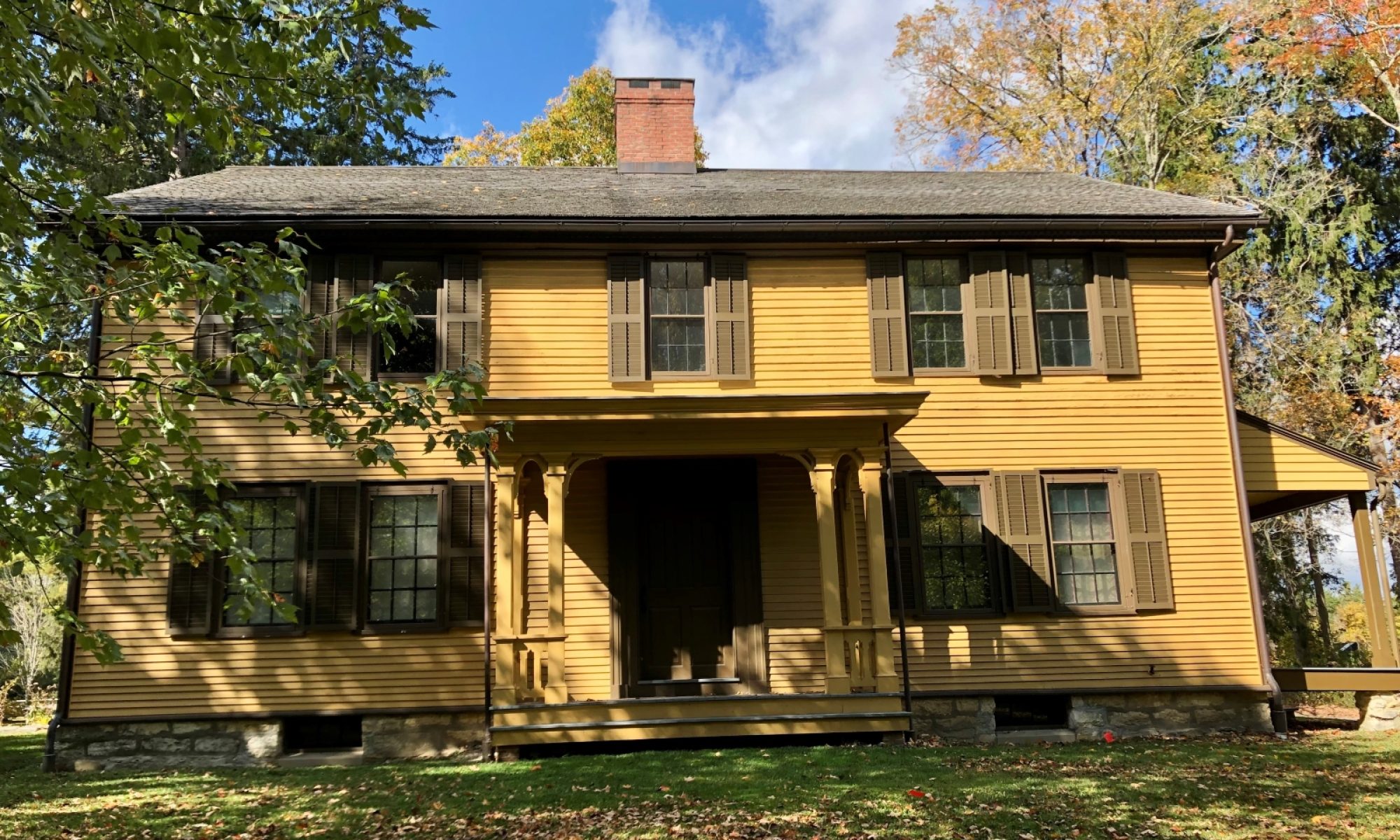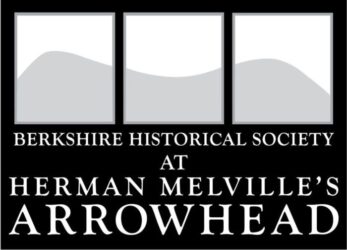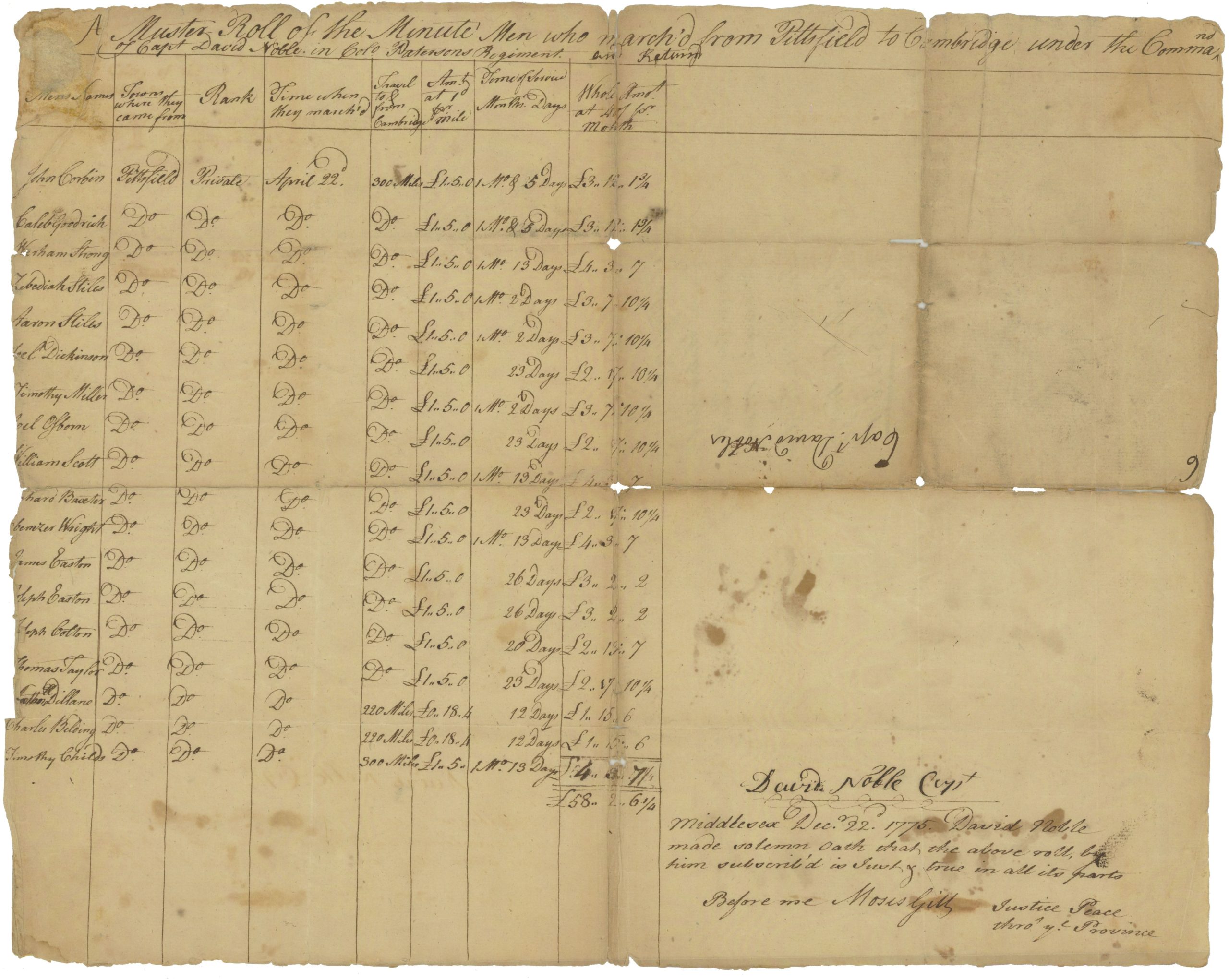“A Muster Roll of the Minute Men who marched from Pittsfield to Cambridge under the Command of Capt. David Noble in Colo. Paterson’s Regiment and Returned”
Handwritten in ink on paper probably by Captain David Noble (1732-1776)
Subscribed by Capt. Noble and Justice of the Peace Moses Gill (1734-1800), December 22, 1775, Cambridge, Middlesex County, Massachusetts
This muster roll is a travel, service, and pay record of 18 Minute Men who responded to the Lexington/Concord Alarm, did not at that time enlist in the Colony army being formed at headquarters in Cambridge and therefore returned home by order. They were all from Pittsfield and ranked as privates in the minute company of Captain David Noble. Many, including Dr. Childs, aged 27, whose name appears last in the first column, enlisted a few weeks later. The eight columns register their names, town, rank, marching date, round-trip mileage, travel pay, service time, and sum total of travel and service pay. This small document opens the door to a stirring time in American history.
At sunrise on Saturday, April 22, 1775, an array of 65 armed Minute Men began a 150-mile march to Cambridge in response to the Lexington/Concord Alarm. The news had reached them on the previous day by couriers who had ridden day and night by relays. True to their name and to a vote of the Pittsfield town meeting held January 24, 1775, they were “ready at a minute’s warning to march and to oppose the Enemies of our Country if called thereto.” They were under the command of Capt. Noble, who had raised this company of volunteers and drilled them through the winter. In the company were two lieutenants, four sergeants, four corporals, fifty-three privates, one fifer, and one drummer. Most were from Pittsfield, about a third from Richmond, and the fifer was from Lenox. Upon reaching Cambridge in seven days, Capt. Noble and 47 of his company, or just less than three-quarters of it, enlisted in the army being formed there. The present muster roll relates to those of the company who remained Minute Men, did not enlist then and soon went home. They were paid one pence (abbreviated d) per mile and, as privates, forty shillings per lunar month for their service. The sum total in pounds, shillings, and pence to be received by each man is recorded in the eighth and final column. (Twelve pence equal 1 shilling; 20 shillings equal 1 pound.) Some served for as little as twelve days; others for as long as one month and thirteen days. Dr. Childs was among those who served the longest. By early June all appear to have come home. They will not therefore have had a part in the pivotal Battle of Bunker Hill, on June 17, 1775.
Although complete in itself, the muster roll is in fact half of an original document. On file in the Massachusetts State Archives in the State House in Boston is the full copy of the original. It consists of two sheets glued together, one above the other: the upper sheet relates to the Minute Men in Capt. Noble’s company who enlisted immediately upon arrival at headquarters. The lower sheet provides the following: a brief continuation of the columns and rows of the upper; three lines of text; the same columnar content of the present muster roll, with names listed in the same order but with variant spellings and in a less fine hand; and at the bottom a different date (January 1776) and the signature of a different justice of the peace. The reason for the differentiation between those who enlisted without returning home and those who returned is that mileage and travel pay were deliberately omitted from the rolls of the former; it was to their army superiors that they reported their travel information for payment. Minute Men companies were at the top of the militia system and formed an élite corps, many members of which became the backbone of the Continental Army.
The genesis of the document was a resolve of the Provincial Congress, which required that muster rolls relating to the April 19th mobilization be submitted by those who were in command of a company so that they could receive pay for the men. They were to make out the rolls and take them to the justice of the peace of their respective counties. Thus, nine months after the Alarm, Capt. Noble came before Moses Gill, the Justice of the Peace “through ye Province,” the Province being Massachusetts Bay. The place is given as the county of Middlesex; the county seat of Cambridge is understood; the siege of Boston, begun definitively with the Battle of Bunker Hill, was still in effect, and the British did not evacuate the city until three months later, in March 1776. Therefore Capt. Noble, who had enlisted in the Provincial Army upon arriving in Cambridge and who was one of the besiegers in Fort No. 3 set up by Paterson’s Regiment three miles due west of Bunker Hill, did not have to go far. He submitted the present roll, and the justice signed it. At some point thereafter he will have been informed that he needed to include the other members of the company who had responded to the Alarm. In January this was done, when the justice signed the above mentioned glued copy as well as presumably a separate roll of those of the company who had immediately enlisted. The captain will then have taken the originals and the copy to Watertown, the provisional Capital of Massachusetts during and a little while after the siege, to “The Committee appointed to approve Muster Rolls,” which compared them and affirmed the copy as true. He retained the originals; others took charge of the copy, which was taken to the Provincial Congress where payment was approved. Then it was noted on the copy that a warrant be drawn on the treasury for the amount specified on the roll, and the copy was signed by the treasurer. The minter of the currency in the treasury was no less than the patriot silversmith Paul Revere, who was living in Watertown during the siege. The penultimate step was the disbursement of the money to the captain who in turn disbursed it to the men. The final step, for our purposes, was the safekeeping of the copy. It is today among 441 stored in the Massachusetts State Archives, 37 percent of which are Minute-Men muster rolls, the remainder being those of the regular militia, which also responded to the Alarm.
Moses Gill (1734-1800) was a prosperous landowner, judge, and one of fifteen councilors who governed Massachusetts during the Revolution. When he signed the muster roll, he had earlier in the year been in the committee sent to Springfield to receive and escort General Washington to Cambridge where on July 3, 1775, Washington assumed command of the Continental Army investing Boston. A Lieutenant Governor for several terms, Gill was Acting Governor at the time of his death. The eminent American artist John Singleton Copley (1738-1815) painted a miniature of him c. 1759 (now in the collection of the Metropolitan Museum of Art) and an oil-on-canvas portrait in 1764 (Rhode Island School of Design Museum of Art).
Colonel John Paterson (1744-1808), a lawyer, was in most of the decisive battles of the war and served to its close in 1783. East of Cambridge, his regiment built and garrisoned Fort No. 3. During the Battle of Bunker Hill, he prevented the landing of British troops and their attacking the rear of the Continental Army. After the siege, his regiment was ordered first to Staten Island for the defense of New York and next to Canada for the relief of the Army there. On December 25, 1776, he and his Berkshire reinforcements crossed the Delaware with General Washington; soon he was made Brigadier General. He passed the hard winter of 1777-78 at Valley Forge. He commanded West Point in 1780. Lenox was his home from 1774 to 1790; his remains lie in its churchyard; an obeliscal monument to him stands in the town center, at the intersection of Routes 7A and 183.
Captain David Noble (1732-1776) owned farms, a saddler’s shop and tannery, and, when very young, was a shoemaker and a builder. He expended his fortune and his life in the service of his country. He sold two farms to buy arms and uniforms for the men of his later Continental company (either the 26th Continental as it was after July 1775 or the 15th Continental when it continued in 1776), not to be confused with the Minute company referenced in this document. Regarding the leather breeches that were part of that uniform, the five and a half dozen of them were made up at his Pittsfield house out of deer skins that he had purchased in Philadelphia by a breeches maker that he had hired. He was in Paterson’s Regiment from April 1775 until his death. He succumbed to the secondary effects of smallpox in what is now Whitehall, New York, near the southern extremity of Lake Champlain, on August 5, 1776.
Dr. Timothy Childs (1748-1821) was first a Minute Man for one month and thirteen days and then the surgeon of Colonel Paterson’s Regiment for eighteen months, from June 28, 1775, until the end of 1776. (From the beginning of 1776, the regiment was officially the 15th Continental Infantry.) Well before the war, he had urgently advised smallpox inoculation despite strenuous popular prejudice against it. The biographer of Paterson speculates that he may have followed Dr. Childs’ advice because, although greatly exposed to the ravages of smallpox when it struck his troops, he never contracted it.
James Easton, Jr. (1756-1810) and his brother Joseph (1754-1819), aged 19 and 20 respectively (7th and 6th from the bottom of the list), were in the same company of Minute Men as their future brother-in-law, Dr. Childs. Meanwhile, their father, James Easton, Sr. (1728-1796) (later Colonel), who was a builder and store and tavern keeper as well as a prominent Pittsfield citizen and longtime friend of Ethan Allen, helped plan and execute the first offensive military action against the British: the capture of Fort Ticonderoga. Participating was John Brown (1744-1780), a Pittsfield lawyer. Five years later, Colonel Brown was killed in a devastating ambush at Stone Arabia, roughly midway between Utica and Albany; his adjutant was Lieutenant James Easton, Jr.
Gift of Michael Tyler, LA2004.005.01


